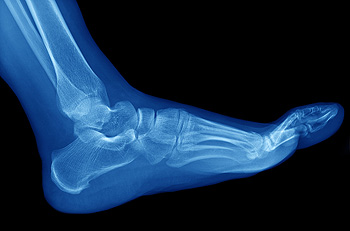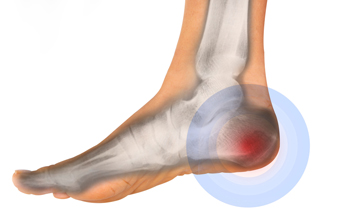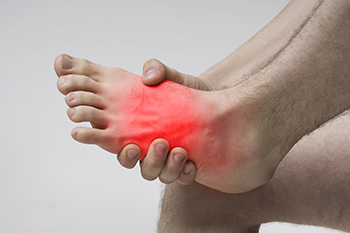Glen Allen Office
(804) 747-3380

If you are a runner, then you are undoubtedly familiar with the importance of selecting the right kind of running shoes. The shoes that you select for runs can have a significant impact on your gait and running form. Selecting shoes that are ill-fitting may lead to injuries or foot complications. One important consideration to keep in mind when shopping for a pair of running shoes is what kind of terrain you will be running on. For example, if you run on roads or sidewalks, you can select road-running shoes. These shoes can be used to run on pavement, and they are built with cushioning that keeps the feet balanced when repeatedly striking hard surfaces. It is important to note that this type of shoe is made for running on mostly even surfaces. On the other hand, if you run on trails, then you might consider purchasing trail-running shoes. This kind of shoe is made to traverse uneven terrain and it has cleats on the outsole for gripping purposes. The midsoles on this kind of shoe tend to be stiffer to help navigate these uneven surfaces. If you are a runner, contact a podiatrist for tips on selecting the best pair of running shoes.
If you are a runner, wearing the right running shoe is essential. For more information, contact one of our podiatrists from The Podiatry Center. Our doctors can provide the care you need to keep you pain-free and on your feet.
Choosing the Right Running Shoe for Your Foot Type
To increase performance and avoid the risk of injury, it is important to choose the right running shoe based on your foot type. The general design of running shoes revolves around pronation, which is how the ankle rolls from outside to inside when the foot strikes the ground.
If you have any questions please feel free to contact one of our offices located in Richmond and Glen Allen, VA . We offer the newest diagnostic and treatment technologies for all your foot and ankle needs.

The movement of the body is referred to as biomechanics. Biomechanics of the feet refer to the movement of the feet and ankles. One of the functions of the ankle is to transfer the forces from the foot to the leg. Ligaments, muscles, and tendons connect the three bones that the ankle is made of and allow the foot to move up and down. The walk cycle, which is known as the gait, is divided into two phases known as the swing and stance phases. The former happens when the foot swings forward and is not in contact with the ground. The latter occurs when the foot hits the ground and this phase is split into three categories: heel strike, midstance, and heel lift. The heel strike allows the foot to roll inward known as pronation. This allows the foot to absorb the shock that comes from walking on different surfaces. The midstance allows the weight of the body to be directly over the foot as contact with the ground is made. When the foot rolls outward this describes the heel lift, and it activates the bones, muscles, and plantar fascia to work together as steps are taken. The foot is a complex structure and if you would like to learn more about how it works, please consult with a podiatrist.
If you have any concerns about your feet, contact one of our podiatrists from The Podiatry Center. Our doctors can provide the care you need to keep you pain-free and on your feet.
Biomechanics in Podiatry
Podiatric biomechanics is a particular sector of specialty podiatry with licensed practitioners who are trained to diagnose and treat conditions affecting the foot, ankle and lower leg. Biomechanics deals with the forces that act against the body, causing an interference with the biological structures. It focuses on the movement of the ankle, the foot and the forces that interact with them.
A History of Biomechanics
Modern technological improvements are based on past theories and therapeutic processes that provide a better understanding of podiatric concepts for biomechanics. Computers can provide accurate information about the forces and patterns of the feet and lower legs.
Understanding biomechanics of the feet can help improve and eliminate pain, stopping further stress to the foot.
If you have any questions please feel free to contact one of our offices located in Richmond and Glen Allen, VA . We offer the newest diagnostic and treatment technologies for all your foot and ankle needs.

A stress fracture is considered to be a hairline fracture. It can happen in the foot, and is often the result of participating in running and jumping activities. It occurs when the bones become fatigued, and cannot support the shock that comes from activity. It generally develops gradually, and many people tend to ignore the pain and discomfort that often accompanies this type of injury. Common symptoms that many patients notice include swelling at the end of the day, and it is difficult to walk as the fracture gets worse. Relief may be found when a boot is worn, and this may provide adequate support as the healing process occurs. This typically takes approximately six weeks, and is further evaluated to see if additional treatment is needed. Mild stretches may accelerate the healing process, which may be beneficial in strengthening the overall foot. If you have foot pain and feel it may be a stress fracture, please confer with a podiatrist as quickly as possible who can diagnose and treat this condition.
Stress fractures occur when there is a tiny crack within a bone. To learn more, contact one of our podiatrists from The Podiatry Center. Our doctors can provide the care you need to keep you pain free and on your feet.
How Are They Caused?
Stress fractures are the result of repetitive force being placed on the bone. Since the lower leg and feet often carry most of the body’s weight, stress fractures are likely to occur in these areas. If you rush into a new exercise, you are more likely to develop a stress fracture since you are starting too much, too soon. Pain resulting from stress fractures may go unnoticed at first, however it may start to worsen over time.
Risk Factors
Stress fractures do not always heal properly, so it is important that you seek help from a podiatrist if you suspect you may have one. Ignoring your stress fracture may cause it to worsen, and you may develop chronic pain as well as additional fractures.
If you have any questions, please feel free to contact one of our offices located in Richmond and Glen Allen, VA . We offer the newest diagnostic and treatment technologies for all your foot care needs.

There are many different causes of heel pain. One potential cause of your heel pain is known as a bruised heel. This condition essentially targets the skin and fat cushioning that protects the heel bone. Bruised heels can result from trauma that happens slowly over time, such as the repeated and sustained impact on the heel from running or jumping. However, bruised heels can also come about in response to a one-time traumatic injury. The most noticeable and prominent symptom of this condition is pain at the bottom of the heel bone, also known as the calcaneus. Importantly, the pain that is felt from a bruised heel is typically not as long-lasting as that felt from plantar fasciitis. Another symptom of bruised heels is a purple or red color on the heel. This discoloration is a sign of a bruise and results from bleeding that is happening underneath the skin. There are a variety of risk factors that can increase your likelihood of developing a bruised heel. For example, if you are significantly overweight or you run barefoot, then you might be more susceptible to developing a bruised heel. If you think that you may be suffering from this condition, reach out to a podiatrist who can help with treatment options.
Many people suffer from bouts of heel pain. For more information, contact one of our podiatrists of The Podiatry Center. Our doctors can provide the care you need to keep you pain-free and on your feet.
Causes of Heel Pain
Heel pain is often associated with plantar fasciitis. The plantar fascia is a band of tissues that extends along the bottom of the foot. A rip or tear in this ligament can cause inflammation of the tissue.
Achilles tendonitis is another cause of heel pain. Inflammation of the Achilles tendon will cause pain from fractures and muscle tearing. Lack of flexibility is also another symptom.
Heel spurs are another cause of pain. When the tissues of the plantar fascia undergo a great deal of stress, it can lead to ligament separation from the heel bone, causing heel spurs.
Why Might Heel Pain Occur?
Treatments
Heel pain should be treated as soon as possible for immediate results. Keeping your feet in a stress-free environment will help. If you suffer from Achilles tendonitis or plantar fasciitis, applying ice will reduce the swelling. Stretching before an exercise like running will help the muscles. Using all these tips will help make heel pain a condition of the past.
If you have any questions please contact one of our offices located in Richmond and Glen Allen, VA . We offer the newest diagnostic and treatment technologies for all your foot and ankle needs.

Do your feet ever feel hot at night? Tingly? Numb? Hot feet can be caused by a variety of conditions. They can range from lifestyle factors and minor foot conditions to more serious underlying medical conditions. For instance, poor footwear and sock choices can make your feet feel hotter than normal, as can certain vitamin deficiencies, Athlete’s foot, alcohol abuse, and hormonal changes during menopause or pregnancy. Several serious medical conditions can also produce hot feet such as diabetic neuropathy, which can affect people with type 1 or type 2 diabetes, Charcot-Marie-Tooth disease (CMT), chronic kidney disease, hypothyroidism, vasculitis, erythromelalgia, side effects of chemotherapy, and more. It is suggested that you make an appointment with a podiatrist to pinpoint the cause of your hot feet—particularly if you’ve been exposed to toxins, experienced a loss of feeling in the toes or feet, or your symptoms have come on suddenly.
Foot Pain
Foot pain can be extremely painful and debilitating. If you have a foot pain, consult with one of our podiatrists from The Podiatry Center. Our doctors will assess your condition and provide you with quality foot and ankle treatment.
Causes
Foot pain is a very broad condition that could be caused by one or more ailments. The most common include:
Diagnosis
To figure out the cause of foot pain, podiatrists utilize several different methods. This can range from simple visual inspections and sensation tests to X-rays and MRI scans. Prior medical history, family medical history, and any recent physical traumatic events will all be taken into consideration for a proper diagnosis.
Treatment
Treatment depends upon the cause of the foot pain. Whether it is resting, staying off the foot, or having surgery; podiatrists have a number of treatment options available for foot pain.
If you have any questions, please feel free to contact one of our offices located in Richmond and Glen Allen, VA . We offer the newest diagnostic and treatment technologies for all your foot care needs.